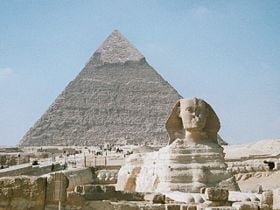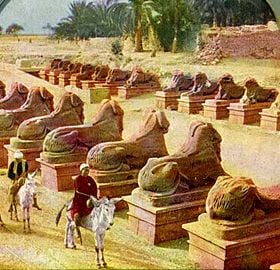Sphinx

- For other uses, see Sphinx (disambiguation).
Sphinx is an iconic image of a recumbent lion with the head of a ram, of a falcon or of a person, invented by the Egyptians of the Old Kingdom, but a cultural import in Greek mythology.
Egyptian sphinx
The sphinx of Giza is an ancient iconic mythical creature usually comprised of a recumbent lion — animal with sacred solar associations — with a human
head, usually that of a pharaoh.
Seen as guardians in the egyptian statuary, sphinxes are depicted in one of these three forms:
Androsphinx - body of lion with head of person;
Criosphinx - body of lion with head of ram;
Hierocosphinx - body of lion with head of falcon or hawk.
The largest and most famous is Sesheps, the Great Sphinx of Giza, sited on the Giza Plateau on the west bank of the Nile River, facing due east, with a small temple between its paws. The face of the Great Sphinx is believed to be the head of the pharaoh Khafra (often known by the Greek version of his name, Chephren) or possibly that of his brother, the Pharaoh Djedefra, which would date its construction from the fourth dynasty (2723 B.C.E.–2563 B.C.E.). However, there are some alternative theories that re-date the Sphinx to the pre-Old Kingdom – and, according to one hypothesis, to prehistoric times. Other famous Egyptian sphinxes include the alabaster sphinx of Memphis, currently localizated within the open-air museum at that site; and the ram-headed sphinxes (in Greek, criosphinxes) representing the god Amon, in Thebes, of which there were originally some nine hundred. What name or names the builders gave to the statues is unknown. The inscription on a stele in the Great Sphinx dates it from one thousand years after the carving of the Sphinx,[1] gives three names of the sun: Kheperi - Re - Atum. The Arabic name of the Great Sphinx, Abu al-Hôl, translates as "Father of Terror". The Greek name "Sphinx" was applied to it in the Antiquity. But it has the head of a man, not of a woman.
Greek sphinx
There was a single Sphinx in Greek mythology, a unique demon of destruction and bad luck, according to Hesiod a daughter of Echidna and of Orthrus or, according to others, of Typhon and Echidna — all of these chthonic figures. She was represented in vase-painting and bas-reliefs most often seated upright rather than recumbent, as a winged lion with a woman's head; or she was a woman with the paws, claws and breasts of a lion, a serpent's tail and eagle wings. Hera or Ares sent the Sphinx from her Ethiopian homeland (the Greeks remembered the Sphinx's foreign origin) to Thebes and, in Sophocles Oedipus Tyrannus, asks all passersby history's most famous riddle: "Which creature in the morning goes on four feet, at noon on two, and in the evening upon three?" She strangled anyone unable to answer. The word "sphinx" comes from the Greek Σφινξ — Sphinx, apparently from the verb σφινγω — sphingo, meaning "to strangle". This may be her proper name, but The Penguin Dictionary of Classical Mythology states that her given name was Φιξ — Phix. Oedipus solved the riddle: man — he crawls on all fours as a baby, then walks on two feet as an adult, and walks with a cane in old age. Bested at last, the Sphinx then threw herself from her high rock and died. An alternative version tells that she devoured herself. The exact riddle asked by the Sphinx was not specified by early tellers of the story and was not standardized as the one given above until much later in Greek history.[2] Thus Oedipus can be recognized as a liminal or "threshold" figure, helping effect the transition between the old religious practices, represented by the Sphinx, and new, Olympian ones.
Similar creatures
Not all human-headed animals of antiquity are sphinxes. In ancient Assyria, for example, bas-reliefs of bulls with the crowned bearded heads of kings guarded the entrances to temples. In the classical Olympian mythology of Greece, all the deities had human form, though they could assume their animal natures as well. All the creatures of Greek myth that combine human and animal form are survivals of the pre-Olympian religion: centaurs, Typhon, Medusa, Lamia. In Hindu tradition, one of the Avatars of Vishnu was the Narasimha which means 'man-lion'. The Avatar had a human body and the head of a lion.
Mannerist Sphinx
The revived Mannerist Sphinx of the 16th century is sometimes thought of as the French Sphinx. Her lovely coiffed head is erect and she has the pretty bust of a young woman. Often she wears ear drops and pearls. Her body is naturalistically rendered as a recumbent lion. Such Sphinxes were revived when the grottesche or "grotesque" decorations of the unearthed "Golden House" (Domus Aurea) of Nero were brought to light in late 15th century Rome, and she was incorporated into the classical vocabulary of arabesque designs that was spread throughout Europe in engravings during the 16th and 17th centuries. Her first appearances in French art are in the School of Fontainebleau in the 1520s and 30s; her last appearances are in the Late Baroque style of the French Régence (1715–1723).
19th century and symbolism
Sphinxes were too somber perhaps for the Rococo, and they tended to disappear from the European design repertory - until revived in the 19th century with its romanticism, and later symbolism. Many of these sphinxes alluded to the Greek sphinx, rather than the Egyptian.
Sphinxes mentioned in fiction and games
Sphinxes often appear in fantasy literature and role-playing games as races or species of monstrous creatures with the head of a person and the body of a lion, usually also with a pair of wings or the hind quarters of a bull.
- The Dungeons & Dragons Sphinx.
- In the video game Age of Mythology.(a playable character when using the egyptian civilization)
- In the novel Harry Potter and the Goblet of Fire Harry encounters a sphinx that has been placed in a maze. Fantastic Beasts and Where to Find Them reveals more information about the nature of Egyptian sphinxes in the Harry Potter world.
- In the comic Cerebus, issue #300, Cerebus's son Shep-Shep (or She-Shep, Egyptian for "living symbol") visits Cerebus and brings a box containing a baby sphinx that was created by splicing his genes with those of a lion, with which Shep-Shep intends to rule Egypt as a god.
- In the video game Sphinx and the Cursed Mummy, the protagonist is based on the Great Sphinx of Giza.
- In the video game Pharaoh, the Great Sphinx of Giza may be constructed as a monument during one of the game's campaign missions.
- In Terry Pratchett’s Discworld novel, Pyramids, the Sphinx roams a border between parallel universes, accessible only between Tsort and Ephebe, when the Kingdom Djelibeybi has disappeared. Djelibeybi’s King, Teppic, encounters the Sphinx who presents him with the generic riddle. Teppic confuses the Sphinx by pointing out the obvious technical errors in the riddle – The riddle turns into: “What, metaphorically speaking, walks on four legs just after midnight, on two legs for most of the day…, barring accidents, until at least supper-time… when it continues to walk on two legs or with any prosthetic aids of its choice?” - therefore managing to escape being eaten by the dreaded creature.
- In the RPG Adventure Quest, Sphinxes are enemies fought when around level 45 or so. They attack with powerful strikes and have a lot of HP.
- In the Film MirrorMask, Sphinxes are ravenous creatures warded off by feeding them books. One guards the entrance to where the Stone Golems reside and asks a riddle of Helena.
See also
- Great Sphinx of Giza
- Egypt
- Giza
- Abtin
Notes
- ↑ It was erected in 1400, probably by Thutmose.
- ↑ Edmunds, Lowell (1981). The Sphinx in the Oedipus Legend. Königstein im Taunus: Hain. ISBN 3-445-02184-8.
External links
- [[1]] - The Classics Pages: Oedipus & the Sphinx
Credits
New World Encyclopedia writers and editors rewrote and completed the Wikipedia article in accordance with New World Encyclopedia standards. This article abides by terms of the Creative Commons CC-by-sa 3.0 License (CC-by-sa), which may be used and disseminated with proper attribution. Credit is due under the terms of this license that can reference both the New World Encyclopedia contributors and the selfless volunteer contributors of the Wikimedia Foundation. To cite this article click here for a list of acceptable citing formats.The history of earlier contributions by wikipedians is accessible to researchers here:
The history of this article since it was imported to New World Encyclopedia:
Note: Some restrictions may apply to use of individual images which are separately licensed.


